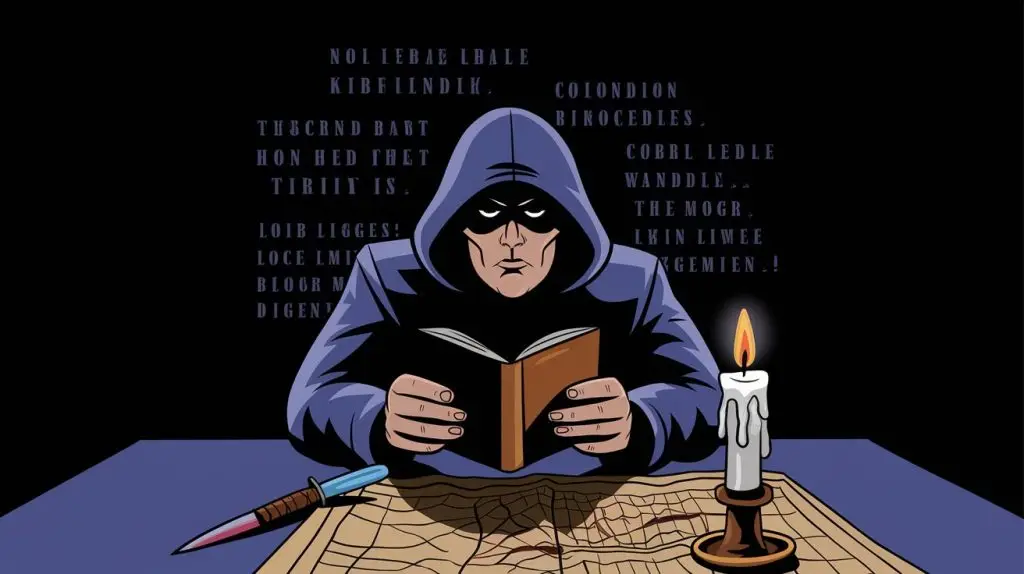The Zodiac Killer’s Coded Messages. Amid the foggy mysteries of California’s past, the Zodiac Killer stands out as a chilling enigma. This serial killer baffled investigators with his cryptic letters and murders. The unsolved nature of these crimes and the coded messages sent to newspapers have captured public attention for decades. The mix of fear and intrigue around the killer’s work fuels ongoing discussions and analysis.

The Zodiac sent four complex ciphers that kept both amateur sleuths and experts on their toes. What’s fascinating is that while these messages were meant to puzzle the FBI and police, breakthroughs still happen thanks to modern technology and relentless dedication. Recent efforts have successfully cracked one of the killer’s toughest ciphers, shedding new light on this long-standing mystery. This success showcases the blend of human ingenuity and digital advancement that continues to delve into the past.
Exploring these mysterious messages offers an opportunity to dive into the mind of a notorious criminal. The coded letters reveal both taunts and twisted psychology, giving us a glimpse into the Zodiac Killer’s world. For true crime fans and history buffs alike, unraveling these messages brings a thrilling challenge and a chance to engage with one of history’s darkest puzzles.
Historical Context of the Zodiac Killer
In the late 1960s and early 1970s, the Zodiac Killer struck fear into the hearts of people in Northern California, especially in the Bay Area. This unidentified serial killer left five confirmed victims and sent taunting letters to local newspapers. The events surrounding the Zodiac Killer remain shrouded in mystery.
Chronology of Terror
The Zodiac Killer’s reign of terror began in the late 1960s. His first confirmed attack was in December 1968.
Many of his victims were young couples in secluded spots. By the summer of 1969, the Zodiac sent ciphers to newspapers around San Francisco. The most famous of these was the 408-character cipher. Even though many ciphers were cracked, the Zodiac’s true identity remained elusive.
Murders attributed to the Zodiac ceased by the early ’70s, yet he claimed 37 victims in his letters. Despite the fear and chaos he created, authorities never fully pieced together his pattern or motive. The late-night attacks, cryptic messages, and sheer randomness of his actions baffled many.
The Mystery Behind the Identity
The Zodiac Killer’s identity is one of the world’s greatest criminal mysteries. While he taunted authorities and the media with letters, he also bragged about avoiding capture.
Over the decades, many suspects have been considered, but none conclusively matched the evidence. The media frenzy and public fear were largely fueled by his communicating through letters.
Among his messages was the infamous 340-character cipher, solved decades later. Despite this breakthrough, his personal history and true nature remain unknown. Many theories about who he might have been circulate, adding to the mystique. The Zodiac’s ability to disappear without a trace makes him a notorious figure in American criminal history.
Decoding the Ciphers
The Zodiac Killer’s encrypted messages were initially a major puzzle, becoming infamous in cryptography circles. Over the years, breakthroughs in decryption have shed light on these complex codes, bringing new insights.
Understanding Cryptograms
Cryptograms are like super-secret puzzles. The Zodiac Killer used these to carry out a game of cat and mouse.
His first code, the 408-character cipher, wasn’t too tricky. In 1969, it was cracked by Bettye June Harden and her husband.
The challenge grew with the 340-character cipher, which stumped even the FBI for years.
Cryptographers finally cracked it in 2024, identifying patterns and symbols to unlock the message. Recognizing synonyms, common words, and linguistic clues was key. These decoding processes showed the depth and skill in handling cryptograms.
Significant Breakthroughs
Cracking the ciphers was like finishing a puzzle with no picture. It took years of collective effort. The first major success came when the Harden duo decoded the initial message, verifying the killer’s taunts.
The next big success was the breakthrough with the Zodiac’s Z340 cipher, thanks to an international team of experts.
This massive effort involved new algorithms that examined each letter. It highlighted how technology and collaboration can solve historical mysteries.
Understanding these breakthroughs shows how advancements, teamwork, and tenacity can unravel even the toughest coded messages.
Techniques in Cryptanalysis
Cryptanalysis relies on a blend of number crunching and powerful computer algorithms to crack codes. It involves methods like homophonic substitution and transposition, crucial for understanding complex ciphers. The efforts of codebreakers and cryptographers are vital for success in this field.
Applied Mathematician’s Tools
Cryptographers and mathematicians often use a range of mathematical techniques to crack ciphers.
Homophonic substitution is one such strategy. This method replaces letters with multiple symbols, making it hard to decode.
Another tactic is transposition, which rearranges the characters in the message.
By using these methods, they aim to uncover patterns and break down the code’s secrecy.
An example is the mathematician’s work on the Zodiac Killer’s ciphers, which helped unlock long-held secrets. These approaches form the backbone of codebreaking, allowing them to decrypt even the most enigmatic messages.
Role of Computers in Cryptanalysis
Computers play a crucial role in modern cryptanalysis. They can quickly evaluate vast numbers of possible solutions, making tasks that would take humans years much faster.
Jarl Van Eycke’s code-breaking software is one example where computing power cracked the Zodiac Killer’s code efficiently.
This technology processes data at high speeds, utilizing algorithms to solve complex ciphers far beyond manual capabilities. Cryptographers combine these computational tools with their expertise, helping them decrypt messages faster and more accurately. This perfect synergy between human mind and machine is what makes these breakthroughs possible.
Notable Codebreakers and Their Contributions

The Zodiac Killer’s coded messages have intrigued codebreakers for decades. Both amateurs and professionals have been instrumental in cracking these cryptic ciphers using traditional methods and modern technology.
Individual and Collective Efforts
A mix of lone wolves and team players tackled the Zodiac ciphers.
Among the key figures, David Oranchak stands out for his role in decoding one of the killer’s most infamous messages. He teamed up with professional cryptographer Sam Blake and software developer Jarl Van Eycke to decipher the 340-character cipher. Their collaboration proved that sometimes geeky teamwork shines brightest.
Amateur sleuths have also been part of this saga. Back in the late ’60s, a husband-and-wife team cracked the Zodiac’s first cipher within a week.
These amateur enthusiasts demonstrated that you don’t always need a badge or a suit to make a big impact. Their work inspired many others to take a stab at the mystery, proving that curiosity can spark breakthroughs in unexpected places.
Technological Advances in Codebreaking
Over the years, technology has become a game-changer in codebreaking.
In the past, solving complex ciphers relied heavily on pen-and-paper methods, much like squeezing all the toothpaste out with your fingers instead of using a toothbrush. Now, advanced computer algorithms and artificial intelligence have sped up the process.
For instance, Oranchak and his team used software to test millions of potential solutions.
This technological twist helped unlock the Zodiac mystery, combining human intuition and machine power. This breakthrough shows how modern tools can support, and sometimes outpace, traditional techniques. It also highlights how combining skills with smart software can turn impossible puzzles into fun weekend projects.
The Infamous 340 Cipher’s Decryption
The infamous 340 Cipher, associated with the Zodiac Killer, remained unsolved for over 50 years. A team of codebreakers, including David Oranchak and Sam Blake, finally cracked the code, revealing chilling insights.
Breaking Down the 340 Cipher
The 340 Cipher was a puzzle sent by the Zodiac Killer in 1969, leaving many experts scratching their heads. It wasn’t until software developer David Oranchak, along with Sam Blake and Jarl Van Eycke, tackled the code using a program called AzDecrypt that things started to make sense.
This cipher, made up of a 340-character grid, was particularly tricky. It used symbols instead of letters, which sounds like a fun brain teaser until you actually try solving it.
The team used ordinary letters to break down the random-looking symbols, experimenting until they found just the right combinations.
Thanks to advanced computer algorithms, the message came together, revealing eerie words from the killer.
The hard work of these experts finally unlocked the words that many thought would remain a mystery forever. Their breakthrough shows how persistence, combined with technology, can solve even the most perplexing puzzles.
Psychological Insights and Motives
The Zodiac Killer’s psychological game left many clues about his character. His pursuit of infamy, paired with some cryptic threats and messages, hints at a complex mind. Understanding the why behind his actions can offer insights into his motivations, including themes like justice and the afterlife.
Gas Chamber Threats and Cipher Messages
In 1969, the Zodiac Killer sent coded messages to newspapers, often including threats about sending victims to the gas chamber. This chilling detail hints at a fascination with both punishment and control.
It’s believed these messages were designed to terrify and draw public attention.
Using a mix of letters and symbols, the killer crafted puzzles that tantalized and taunted both authorities and the public.
The infamous Z408 code was decoded revealing disturbing but vague threats. Such acts showcased a desire for attention and power, as well as a twisted sense of justice.
Motive for Cryptic Communication
The motive behind the Zodiac Killer’s coded messages seemed driven by a need to assert dominance. By sending these ciphers, he managed to keep the media and police in a constant state of frenzy, which fulfilled his craving for infamy. His letters often combined elements of astrological symbols and riddles, enhancing his mysterious persona.
There was also a peculiar blend of themes involving justice and the afterlife in these messages. The Zodiac Killer’s use of cryptic communication was likely a method to explore the darker sides of human behavior, turning his gruesome acts into some kind of puzzle. Through these actions, he ensured his place in history as a notorious figure.
Impact on Media and Public Perception

The Zodiac Killer captured the public’s imagination and influenced how media reported on crime. The killer’s use of cryptic messages drew media attention, sparking widespread interest and fear.
Media’s Role in the Zodiac Narrative
Media outlets played a huge role in shaping the Zodiac Killer’s story. Newspapers like the San Francisco Chronicle were among the first to receive the chilling letters filled with cryptic codes and threats. These letters increased public curiosity and fear, making the Zodiac Killer headline news.
The press often highlighted the mystery and horror surrounding the crimes. This approach created a macabre fascination and helped the killer gain infamous attention. Such coverage also affected how future crime stories were reported, making the case a landmark in criminal journalism.
Coded Messages and Public Engagement
The Zodiac’s encoded messages intrigued not just the police but also the public. Amateur cryptographers and code enthusiasts joined the chase to solve these riddles. This interaction created a unique relationship between the public and an active criminal investigation.
One message that stood out took 51 years to crack. The effort involved drew people closer to the case, enhancing their fascination with the mystery. The killer’s taunting letters and cryptic ciphers became a phenomenon, turning it into a community puzzle. This public engagement proved the enduring allure of codes and mysteries in capturing people’s imaginations.
The Legacy and Future of Cryptography

Cryptography has shaped history by solving mysteries and protecting secrets. The future holds exciting prospects as technology advances and new challenges emerge. This section explores innovations and their impact on unsolved cases.
Innovations in Cryptology
Cryptography is always evolving, with new methods cropping up to tackle complex puzzles. Mathematicians and computer scientists are at the forefront, crafting algorithms that bolster security.
For instance, quantum cryptography uses principles of quantum mechanics to protect data. This approach makes it nearly impossible for natural interlopers to break codes without detection.
Machine learning is another game-changer, as it helps identify patterns in encrypted messages quicker than traditional methods. As technology progresses, cryptanalysts have more tools to decipher even the toughest encoded messages, pushing the limits of what’s possible and uncovering hidden histories.
Implications for Future Unsolved Cases
Analysis of encoded messages like the Zodiac Killer’s ciphers brings hope for solving other longstanding mysteries.
Improved techniques in codebreaking mean investigators might finally crack other cryptograms tied to ongoing investigations.
Cryptography plays a key role here, providing new ways to understand clues that have baffled detectives for decades.
As technology advances and more sophisticated tools become available, the dream of solving famous cold cases seems increasingly attainable.
These breakthroughs not only close chapters for grieving families but also inspire future cryptographers and enthusiasts alike.
Steve is the creative force behind Unique Tales, a blog dedicated to sharing captivating stories that explore the human experience in all its complexity. With a passion for writing and a talent for crafting engaging narratives, Steve's blog is a treasure trove of imaginative tales that transport readers to other worlds and challenge them to see things from new perspectives. From epic adventures to intimate character studies, Steve's stories are always thought-provoking and emotionally resonant. With a growing following of readers who appreciate his unique voice and creative vision, Steve is quickly becoming a rising star in the world of online storytelling.






